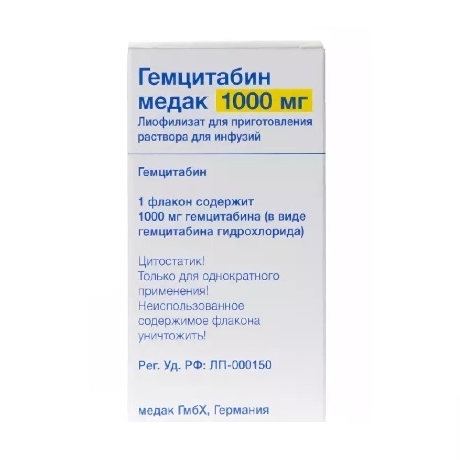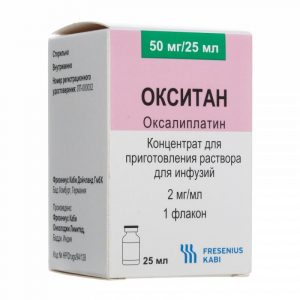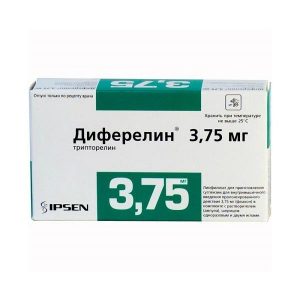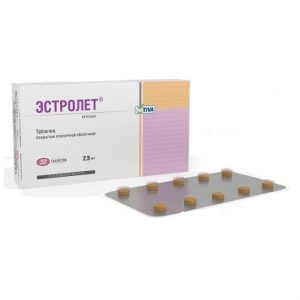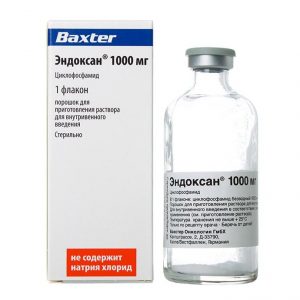Description
Release form
Lyophilisate for the preparation of a solution for infusion of white or almost white color.
Pharmacological action
Antitumor agent, antimetabolite of the pyrimidine analog group, inhibits DNA synthesis. It shows cyclospecificity, acting on cells in phases S and Gl / S. It is metabolized in the cell under the action of nucleoside kinases to active diphosphate and triphosphate nucleosides. Diphosphate nucleosides inhibit the action of ribonucleotide reductase (the only enzyme that catalyzes the formation of deoxynucleoside triphosphates, necessary for DNA synthesis). Triphosphate nucleosides are able to integrate into the DNA chain (to a lesser extent RNA), which leads to the cessation of further DNA synthesis and programmed cell death (apoptosis).
Gemcitabine is also a powerful radiosensitizing agent, even at concentrations lower than cytotoxic.
Pharmacokinetics
Cmax gemcitabine (from 3.2 μg / ml to 45.5 μg / ml) is achieved 5 minutes after the end of the infusion. A pharmacokinetic analysis of single and multiple dose studies indicates that Vd is highly gender dependent. The binding of gemcitabine to plasma proteins is negligible.
In the body, gemcitabine is rapidly metabolized by the action of cytidine deaminase in the liver, kidneys, blood and other tissues, resulting in the formation of gemcitabine mono-, di- and triphosphates (dFdCMP, dFdCDP and dFdCTP), of which dFdCDP and dFdCTP are considered active.
Gemcitabine is rapidly excreted in the urine mainly as an inactive metabolite of 2′-deoxy-2 ‘, 2’-difluoruridine. Less than 10% of the iv dose is found in the urine in the form of unchanged gemcitabine. Systemic clearance, which ranges from about 30 l / h / m2 to 90 l / h / m2, depends on age and gender: the elimination rate in women is about 25% lower than in men, both in men and women, the excretion rate decreases with age.
T1 / 2 ranges from 42 minutes to 94 minutes. Subject to the recommended dosage regimen, complete elimination of gemcitabine occurs within 5-11 hours from the start of nnfusion. When administered once a week, gemcitabine does not accumulate in the body.
Combination therapy with gemcitabine and paclitaxel. With the joint administration of gemcitabine and paclitaxel, the pharmacokinetics of the drugs does not change.
Combination therapy with gemcitabine and carboplatin. With the joint administration of gemcitabine and carboplatin, the pharmacokinetics of gemcitabine does not change.
Impaired renal function. Mild or moderate renal failure (creatinine clearance 30-80 ml / min) does not significantly affect the pharmacokinetics of gemcitabine.
Indications
– locally advanced or metastatic non-small cell lung cancer as a first-line therapy in combination with cisplatin, as well as in monotherapy in elderly patients with a functional status of 2
– unresectable, locally recurrent or metastatic combination breast cancer after neoadjuvant and / or adjuvant therapy with the inclusion of anthracyclines in the absence of contraindications to their prescription
– locally distributed th or metastatic urothelial cancer (cancer of the bladder, renal pelvis, ureter, urethra)
– locally advanced or metastatic epithelial ovarian cancer as monotherapy or in combination with carboplatin in patients with disease progression after the first line of therapy based on platinum-containing drugs
– locally advanced or metastatic pancreatic cancer
– locally advanced metastatic or metastatic cancer.
Contraindications
– hypersensitivity to the active substance or to any of the excipients
– pregnancy and lactation
– children under 18 years of age (lack of sufficient data on efficacy and safety).
With caution: in case of impaired liver and / or kidney function, inhibition of bone marrow hematopoiesis (including the background of concomitant radiation or chemotherapy), a history of cardiovascular disease, with metastatic liver damage, hepatitis, alcoholism, with simultaneous radiation therapy, acute infectious diseases of a viral, fungal or bacterial nature (including chicken pox, shingles).
Use during pregnancy and lactation
Contraindicated: pregnancy and the period of lactation.
Special instructions
Treatment with gemcitabine can only be carried out under the supervision of a doctor with experience in the use of antitumor chemotherapy.
Before each administration of gemcitabine, it is necessary to control the number of platelets, white blood cells and granulocytes in the blood. With signs of inhibition of bone marrow function caused by the drug, it is necessary to suspend treatment or adjust the dose.
Typically, bone marrow suppression is short-term, does not require a dose reduction, and rarely leads to interruption of treatment. Peripheral blood counts may continue to deteriorate after interruption of gemcitabine therapy.
When using gemcitabine in combination with other antitumor chemotherapy drugs, the risk of cumulative suppression of bone marrow function must be considered.
Regular examination of the patient and assessment of renal and hepatic function is necessary.
Administration of gemcitabine in case of liver metastases, history of hepatitis and alcoholism, as well as liver cirrhosis increases the risk of liver failure. If there are signs of the development of adverse effects from the respiratory system (for example, pulmonary edema, interstitial pneumonitis or respiratory distress syndrome in adults) during treatment with gemcitabine, treatment should be discontinued and appropriate therapy should be prescribed.
When the first signs of microangiopathic hemolytic anemia appear, such as a rapid decrease in hemoglobin with concomitant thrombocytopenia, an increase in serum concentrations of bilirubin, creatinine, urea nitrogen, or an increase in lactate dehydrogenase activity, gemcitabine should be discontinued.
An increase in the duration of infusion and the frequency of administration leads to an increase in toxicity.
The risk of skin reactions increases with a history of radiation therapy.
Depending on the degree of toxicity, the dose can be reduced in each cycle or with the start of a new cycle stepwise.
Reliable contraceptive methods should be used during treatment and for 6 months after the end of gemcitabine therapy. Men receiving gemcitabine are advised to resort to Cree.
Reliable contraceptive methods should be used during treatment and for 6 months after the end of gemcitabine therapy. Men receiving gemcitabine are advised to resort to Cree.
Reliable contraceptive methods should be used during treatment and for 6 months after the end of gemcitabine therapy. Men receiving gemcitabine are advised to resort to Cree.sperm preservation before treatment due to the risk of infertility due to the use of this drug
When treating patients on a controlled sodium diet, the sodium content in the following quantities should be taken into account:
vial 200 mg Gemcitabine medak contains 3.5 mg (<1 mmol) of sodium The vial of 1000 mg gemcitabine medak contains 17.5 mg (<1 mmol) of sodium, the vial of 1500 mg gemcitabine medak contains 26.3 mg (<1 mmol) of sodium. Effect on the ability to drive a vehicle and operate machinery. There are no data on the effect of gemcitabine therapy on the ability to drive a vehicle and work with mechanisms, however, some side effects of the drug, such as increased drowsiness, can adversely affect the ability to perform such actions. During treatment with gemcitabine, care must be taken when driving vehicles and engaging in potentially hazardous activities that require an increased concentration of attention and speed of psychomotor reactions. Composition 1 vial: gemcitabine hydrochloride 1138.5 mg, which corresponds to the content of gemcitabine 1000 mg Excipients: mannitol, sodium acetate trihydrate, sodium hydroxide, hydrochloric acid. Dosage and administration of Gemcitabine is administered iv drip for 30 minutes. Non-small cell lung cancer Monotherapy: The recommended dose is 1000 mg / m2 on days 1, 8 and 15 of each 28-day cycle. Combination therapy with cisplatin: the recommended dose is 1250 mg / m2 on the 1st and 8th day of each 21-day cycle or 1000 mg / m2 on the 1st, 8th and 15th days of each 28-day cycle Cisplatin is administered at a dose of 70-100 mg / m2 on the 1st day of the cycle against the background of water load after infusion of gemcitabine. Combination therapy with carboplatin: the recommended dose is 1000 mg / m2 or 1200 mg / m2 on the 1st and 8th day of every 21-day cycle. Carboplatin is administered at a dose of AUC 5.0 mg / ml * min on the 1st day of the cycle after gemcitabine infusion. Breast cancer Combination therapy: as a first-line therapy for the progression of the disease after neoadjuvant therapy, including anthracyclines, the recommended dose of the drug is 1250 mg / m2 on the 1st and 8th days in combination with paclitaxel at a dose of 175 mg / m2, which is administered on the 1st day of each 21-day intravenous drip for about 3 h, before the introduction of gemcitabine. Urothelial cancer Monotherapy: the recommended dose is 1250 mg / m2 on days 1, 8 and 15 of each 28-day cycle. Combination therapy: the recommended dose is 1000 mg / m2 on the 1st, 8th and 15th days in combination with cisplatin, which is administered at a dose of 70 mg / m2 immediately after the infusion of gemcitabine in the 1st or 2nd day of every 28-day cycle. Epithelial ovarian cancer Monotherapy: The recommended dose is 800-1250 mg / m2 on the 1st, 8th and 15th days of each 28-day cycle. Combination Therapy: the recommended dose of the drug is 1000 mg / m2 on the 1st and 8th days in combination with carboplatin at a dose of AUC4.0 mg / ml * min, which is administered immediately after gemcitabine infusion on the 1st day of every 21-day cycle. Pancreatic cancer Monotherapy: the recommended dose is 1000 mg / m2 once a week for 7 weeks, followed by a weekly break. Then the drug is administered on the 1st, 8th and 15th days of each 28-day cycle. Cervical cancer (locally advanced or metastatic) Combination therapy: For locally advanced cancer (neoadjuvant) and metastatic cancer, gemcitabine is administered at a dose of 1250 mg / m2 on the 1st and 8th days of every 21-day cycle. Cisplatin is administered at a dose of 70 mg / m2 after the administration of gemcitabine on the 1st day of the cycle against the background of hyperhydration. Dose corrector for hematologic toxicity Start of the treatment cycle Regardless of the indications, pure platelets and granulocytes must be evaluated before each administration of the drug. The condition for starting treatment is an absolute neutrophil count of at least 1,500 / µl and a platelet count of at least 100,000 / µl. Dose adjustment for non-hematologic toxicity Periodic physical examination and monitoring of liver and kidney function should be performed to identify non-hematologic toxicity. The dose of the drug can be reduced in each subsequent cycle or during the already begun cycle, depending on the degree of manifestation of the toxicity of the drugs prescribed to the patient. In case of severe (3 or 4 degree) non-hematologic toxicity, with the exception of cases of nausea / vomiting, gemcitabine therapy should be suspended or the dosage should be reduced depending on the decision of the attending physician. The decision to resume treatment is made by the doctor. Method of administration The infusion of gemcitabine is usually well tolerated by patients and can be done on an outpatient basis. In case of extravasation, the infusion is stopped and the introduction of the drug into another vein is resumed. After administration of gemcitabine, the patient should be observed for some time. Side effects Adverse reactions that are more common than in single cases are listed inaccording to the following gradation: very often (> 10%) often (> 1% to <10%) infrequently (> 0.1% to <1%) rarely (> 0.01% to <0.1%) very rarely (<0.01%). From the hemopoietic organs: often – leukopenia, neutropenia, thrombocytopenia, anemia often – febrile neutropenia very rarely – thrombocytosis. From the digestive system: very often – nausea, vomiting, increased activity of hepatic transaminases (aspartate aminotransferase, alanine aminotransferase), often alkaline phosphatase – anorexia, diarrhea, constipation, stomatitis, increased bilirubin concentration rarely – increased activity of gamma-glutamyltransferase based on available data – ischemic colitis, toxic liver damage, including fatal liver failure. From the urinary system: very often – mild hematuria and proteinuria, the frequency cannot be estimated on the basis of available summer cures – acute renal failure, clinical signs and symptoms similar to hemolytic-uremic syndrome (decreased hemoglobin, thrombocytopenia, increased bilirubin, creatinine , urea and / or lactate dehydrogenase in serum). From the side of the skin and skin appendages: very often – skin rashes accompanied by itching, alopecia often – itching, excessive sweating rarely – ulceration, blistering, very rarely – severe skin reactions, including desquamation and bullous rashes, the frequency cannot be estimated – Lyell’s syndrome, Stevens-Johnson syndrome. From the respiratory system: very often – shortness of breath often – cough, rhinitis, infrequently – bronchospasm, intertitial pneumonia frequency cannot be estimated – pulmonary edema, acute respiratory distress syndrome. From the cardiovascular system: rarely – a decrease in blood pressure, myocardial infarction, the frequency cannot be estimated – arrhythmia (mainly supraventricular), heart failure, clinical signs of peripheral vasculitis and gangrene. From the nervous system: often – headache, increased drowsiness, insomnia, frequency cannot be estimated – stroke. Others: very often – feeling unwell, flu-like syndrome, peripheral edema often – fever, chills, asthenia, back pain, myalgia rarely – swelling of the face, reactions at the injection site very rarely – anaphylactic reactions. Drug Interactions No specific studies of gemcitabine interactions have been performed. Radiation therapy Concomitant radiation therapy (simultaneously with gemcitabine administration or with an interval <7 days before the start of treatment): in this situation, the toxicity of treatment depends on many factors, including the dose of gemcitabine and its frequency of administration, the radiation dose, the method of radiation therapy, the nature of the radiation therapy tissue and its volume. Gemcitabine has been shown to have radiosensitizing activity. In one study, where patients with non-small cell lung cancer received gemcitabine at a dose of 1000 mg / m2 for 6 consecutive weeks in combination with therapeutic radiation to the chest area, significant toxicity was noted, in the form of severe and potentially life-threatening inflammation of the mucous membrane, mainly esophagitis and pneumonitis , especially in patients with a large volume of tissue irradiation (median volume of irradiated tissue 4795 cm3). Subsequent studies have shown that a combination of lower doses of gemcitabine and radiation therapy is better tolerated by patients and has a predictable toxicity profile. So, in one phase II study, patients with non-small cell lung cancer underwent radiation therapy at a dose of 60 Gy with the introduction of gemcitabine (600 mg / m2 4 times) and cisplatin (80 mg / m2 2 times) for 6 weeks. Sequential therapy (interval> 7 days): according to existing data, the administration of gemcitabine more than 7 days before the start of radiation therapy or more than 7 days after its completion is not accompanied by an increase in toxicity, with the exception of skin lesions associated with the introduction of a chemotherapy after radiation . Treatment with gemcitabine can be started 7 days after irradiation or after resolving all acute radiation reactions.
Both with concomitant use and with consecutive use of gemcitabine and radiation therapy, radiation damage to the irradiated tissues is possible (e.g. esophagitis, colitis and pneumonitis).
Immunosuppressants (azathioprine, chlorambucil, glucocorticosteroids, cyclophosphamide, cyclosporine, mercaptopurine) increase the risk of infections.
Other types of interaction
When used with live viral vaccines, the replication of the vaccine virus may be intensified, its side / adverse effects may increase and / or antibody production in the patient’s body will be reduced in response to the vaccine. Therefore, due to the risk of systemic, possibly fatal complications, especially in patients with reduced immune status, the interval between the use of gemcitabine and such vaccines should be at least 3 months or more (up to 12 months), depending on the patient’s immune status.
Gemcitabine compatibility studies have not been conducted. Do not mix gemcitabine with other drugs.
Overdose of
Symptoms: myelodepression, paresthesia, severe skin rash. With the introduction of gemcitabine in doses up to 5700 mg / m2 iv in 30 minutes every 2 weeks there were no signs of overdose. The antidote for gemcitabine is unknown.
If an overdose of gemcitabine is suspected, the degree of cytopenia should be monitored and symptomatic therapy prescribed.
Storage Conditions
In a dark place at a temperature not exceeding 25 ° C. Keep out of reach of children!
The Expiration of
is 2.5 years. Do not use after the expiry date stated on the packaging.
active substance
Gemcitabine
Prescription conditions from
pharmacies prescription
lekarstvennaja form
Solution for infusion
Onkotek Pharma Production GmbH, Germany
